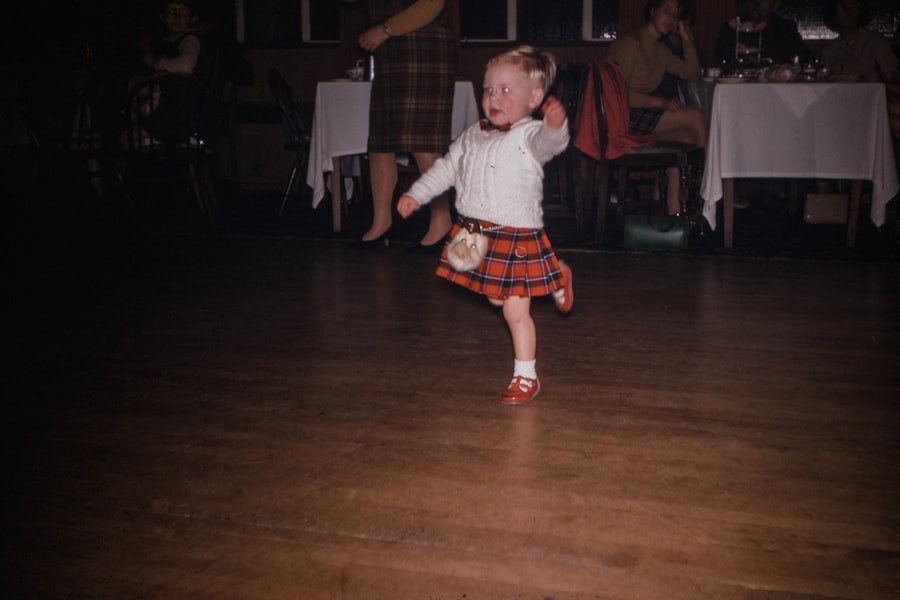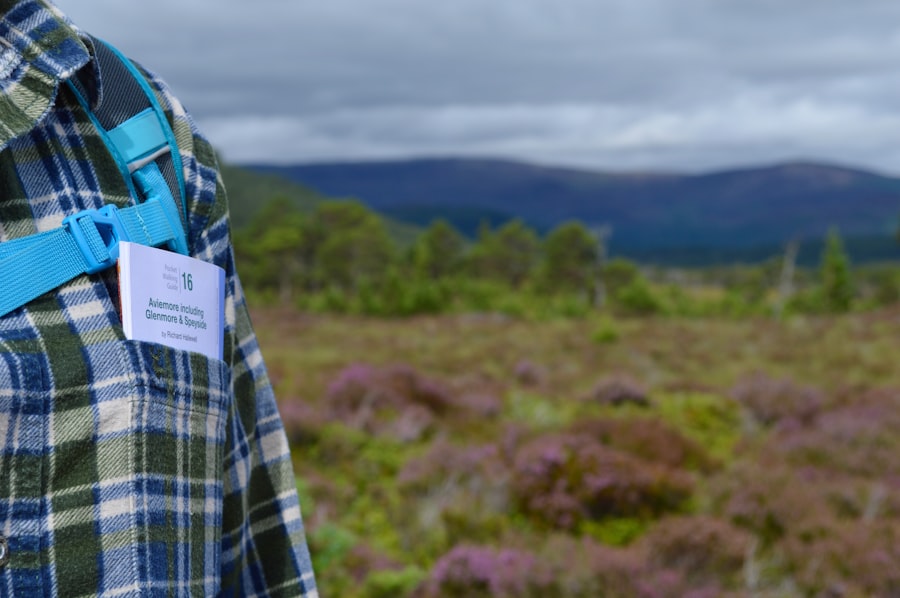When you think of a traditional Scottish wedding, the image of a groom clad in a kilt often springs to mind. This iconic garment is not merely a piece of clothing; it embodies centuries of Scottish heritage and culture. For you, as a groom or groomsman, donning a kilt signifies a deep connection to your roots and an expression of pride in your ancestry.
The kilt, typically made from wool and featuring distinctive tartan patterns, serves as a visual representation of your clan or family lineage. By wearing it on such a momentous occasion, you honour your heritage while also celebrating the union of two families. Moreover, the kilt is steeped in tradition and symbolism.
It is often worn with specific accessories, such as a sporran, which serves both practical and decorative purposes. The sporran, traditionally made from leather or fur, is worn at the front of the kilt and can hold essential items like your wallet or keys. As you prepare for the wedding day, you may find that the kilt not only enhances your appearance but also fosters a sense of camaraderie among the groomsmen.
When you all wear matching or coordinated kilts, it creates a striking visual impact that adds to the overall atmosphere of celebration and unity.
Summary
- The kilt is a significant symbol of Scottish heritage and is often worn by the groom and groomsmen at weddings to honour tradition and family heritage.
- The Ceilidh is a traditional Scottish dance and music event that adds a lively and festive atmosphere to wedding receptions, encouraging guests to join in and celebrate the couple’s special day.
- Bagpipe music holds great significance in Scottish wedding ceremonies, adding a sense of grandeur and tradition to the proceedings.
- Toasting is an important part of Scottish wedding etiquette, with the custom of raising a glass to the newlyweds and delivering heartfelt speeches being a cherished tradition.
- The thistle, as the national flower of Scotland, is often incorporated into wedding decor and traditions to symbolise bravery, devotion, and resilience in marriage.
The Order of the Ceilidh: Exploring the traditional Scottish dance and music at wedding receptions
As the wedding festivities unfold, you may find yourself swept up in the lively atmosphere of a ceilidh. This traditional Scottish dance is an integral part of many weddings, providing an opportunity for guests to engage in spirited movement and joyful celebration. The ceilidh is characterised by its energetic music and simple dance steps, making it accessible for everyone, regardless of their dancing ability.
As you join in the fun, you’ll likely feel a sense of connection with your fellow guests, as everyone comes together to celebrate love and unity through dance. The music at a ceilidh typically features traditional instruments such as fiddles, accordions, and, of course, bagpipes. The lively tunes create an infectious energy that encourages even the most reserved guests to join in.
You might find yourself learning new dances or even leading a group in a traditional Scottish reel. The ceilidh not only serves as entertainment but also fosters a sense of community among guests, allowing them to bond over shared experiences and create lasting memories. As you twirl and spin on the dance floor, you’ll be participating in a time-honoured tradition that has been passed down through generations.
The Role of the Bagpipes: Understanding the significance of bagpipe music in Scottish wedding ceremonies

No Scottish wedding would be complete without the hauntingly beautiful sound of bagpipes. As you prepare for the ceremony, you may feel a sense of anticipation as the piper begins to play. The bagpipes have long been associated with Scottish culture and are often used to mark significant moments during weddings.
From the arrival of the bride to the recessional as newlyweds, the music creates an emotional backdrop that enhances the overall experience. The significance of bagpipe music extends beyond mere entertainment; it serves as a powerful symbol of Scottish identity and heritage. When you hear the distinctive sound of the pipes, it evokes feelings of pride and nostalgia, connecting you to your ancestors and their traditions.
The choice to include bagpipes in your wedding ceremony is not just about aesthetics; it’s about honouring your cultural roots and creating an atmosphere that resonates with meaning. As you walk down the aisle or share your first dance as a married couple, the music will serve as a poignant reminder of your commitment to one another and your shared heritage.
The Toasting Tradition: Exploring the etiquette and customs of toasting at Scottish weddings
Toasting is an essential part of any wedding celebration, but in Scotland, it takes on a unique significance. As you raise your glass during the reception, you participate in a time-honoured tradition that expresses goodwill and best wishes for the couple’s future together. The act of toasting is often accompanied by heartfelt speeches that recount cherished memories or offer words of wisdom.
You may find yourself moved by the sentiments shared by family and friends as they celebrate your love story. In Scottish culture, there are specific customs associated with toasting that you might want to consider. For instance, it is customary for the best man to deliver a toast on behalf of the groom, while the maid of honour may offer her own words for the bride.
As you prepare for these moments, remember that sincerity is key; heartfelt words resonate more than elaborate speeches. Additionally, it’s important to maintain eye contact with those you are toasting as a sign of respect and connection. By embracing these traditions, you not only honour your heritage but also create an atmosphere of warmth and camaraderie among your guests.
The Symbolism of the Thistle: Understanding the significance of the national flower of Scotland in wedding decor and traditions
The thistle holds a special place in Scottish culture, often regarded as a symbol of resilience and strength. As you plan your wedding decor, incorporating this national flower can add layers of meaning to your celebration. The thistle’s striking appearance makes it an attractive choice for floral arrangements or centrepieces, while its historical significance connects you to Scotland’s rich heritage.
By including thistles in your wedding decor, you pay homage to your roots while also celebrating love and unity. In addition to its aesthetic appeal, the thistle carries various interpretations within Scottish folklore. It is said to represent protection and defence, making it an apt symbol for a couple embarking on their journey together.
As you exchange vows and commit to one another, having thistles present can serve as a reminder of your strength as partners facing life’s challenges together. Whether used in bouquets or incorporated into table settings, the thistle adds a touch of authenticity to your wedding while honouring Scotland’s cultural legacy.
The Blessing of the Quaich: Exploring the custom of sharing a ceremonial drink during the wedding ceremony

The quaich is a traditional Scottish drinking vessel that plays an important role in wedding ceremonies. As you participate in this custom, you’ll find that sharing a drink from the quaich symbolises unity and trust between partners. Typically filled with whisky or another beverage of choice, this ritual allows you to share something special with one another while also involving family members or close friends in the experience.
During the ceremony, you may choose to have your parents or other loved ones present as witnesses to this momentous occasion. As they pass the quaich between you and your partner, it signifies not only your commitment to each other but also your willingness to embrace each other’s families and traditions. This act fosters a sense of community and connection among all those present, reinforcing the idea that marriage is not just about two individuals but also about joining families together.
The Importance of Clan Tartans: Understanding the significance of incorporating family tartans into the wedding attire and decor
Tartan is synonymous with Scottish identity, representing various clans and families throughout history. As you plan your wedding attire and decor, considering clan tartans can add a personal touch that reflects your heritage. Wearing tartan sashes or incorporating it into table settings allows you to honour your family lineage while celebrating your union with your partner.
Incorporating clan tartans into your wedding can also serve as a conversation starter among guests who share similar backgrounds or connections to Scotland.
You may find that discussing tartan patterns leads to stories about family history or shared experiences that deepen connections among attendees. By embracing this aspect of Scottish culture, you create an atmosphere rich in tradition while celebrating love and unity.
The Role of the Handfasting Ceremony: Exploring the traditional Scottish ritual of binding the couple’s hands together as a symbol of their union
Handfasting is an ancient Scottish tradition that has seen a resurgence in modern weddings. This ritual involves binding the couple’s hands together with ribbons or cords as a symbol of their commitment to one another. As you participate in this ceremony, you’ll find that it adds depth and meaning to your vows while connecting you to centuries-old customs.
The act of handfasting represents not only physical union but also emotional and spiritual connection between partners. As your hands are bound together, it serves as a powerful reminder that you are embarking on this journey together—facing challenges side by side while celebrating each other’s triumphs. This beautiful ritual can be personalised with colours or materials that hold special significance for both you and your partner, making it an even more meaningful part of your wedding day.
In conclusion, embracing these rich traditions during your Scottish wedding allows you to honour your heritage while creating lasting memories with loved ones. From donning kilts and participating in ceilidhs to sharing drinks from quaichs and incorporating clan tartans into decor—each element contributes to an unforgettable celebration steeped in love and cultural significance. By weaving these customs into your special day, you not only celebrate your union but also pay tribute to generations past who have paved the way for this momentous occasion.
If you are planning your wedding in Scotland and are curious about the role of a humanist celebrant in creating a meaningful ceremony, you might find this article quite enlightening. It delves into how a humanist celebrant can tailor your wedding to reflect your personal values and beliefs, ensuring that your special day is both unique and memorable. For more detailed insights, read the full article here.
FAQs
What are the legal requirements for getting married in Scotland?
In Scotland, both parties must be at least 16 years old to get married. If either party is under 18, they will need parental consent. Both parties must also not be closely related, and must not already be married or in a civil partnership.
Do we need to give notice of our intention to marry in Scotland?
Yes, couples getting married in Scotland must give notice of their intention to marry to the registrar at least 29 days before the date of the wedding. This notice can be given up to 3 months in advance.
Can we have a religious or non-religious ceremony in Scotland?
Yes, couples in Scotland can choose to have either a religious or non-religious ceremony. Religious ceremonies can be conducted by an approved religious celebrant, while non-religious ceremonies can be conducted by a registrar.
Are there any restrictions on where we can get married in Scotland?
In Scotland, couples can get married in a variety of locations, including approved venues, religious premises, and even outdoors. However, the location must be approved by the local council.
Do we need witnesses for our marriage in Scotland?
Yes, in Scotland, couples getting married must have two witnesses present at the ceremony. These witnesses must be over the age of 16 and capable of understanding the nature of the marriage ceremony.

